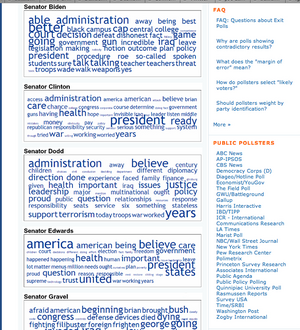Text Clouds of the Democratic Debate
Mark Blumenthal, of Pollster.com, recently posted a set of text clouds showing the words used by each candidate in the Democratic presidential debate Thursday night. The clouds were generated from transcripts of the debate, using Daniel Steinbock’s Tag Crowd tool.
In the screenshot of Mark’s posting, it’s easy to see this is a great example of a collection of text clouds used for comparative visualization and interpretation. The goal is to enhance understanding of the meaning and content of the candidate’s overall conversations during the debate, an idea I explored briefly last year.
Just a month ago, in a post that identified text clouds as a new and distinct tag cloud variant, I suggested:
text clouds may become a generally applied tool for managing growing information overload by using automated synthesis and summarization. In the information saturated future (or the information saturated present), text clouds are the common executive summary on steroids
Supporting the comparison and interpretation of political speeches is an inventive, timely, and resourceful application that could make text clouds a regular part of the new personal and professional toolkit for effectively handling the torrents of information overwhelming people in important situations like vetting political candidates.
I especially like the way this use of text clouds helps neatly sidestep the disheartening ubiquity of the soundbite, by aggregating, distilling, and summarizing all the things the candidates said. I suspect few – if any – of the campaigns realize the potential for text clouds, but they definitely know the detrimental power of soundbites:
“It’s a mess,” said an exasperated-sounding Mr. Prince, Mr. Edwards’s deputy campaign manager. “Debates are important, but in these big multicandidate races they end up not being an exchange of ideas, but just an exchange of sound bites. They have become a distraction.”
From Debates Losing a Bit of Luster in a Big Field
The value of a collection of soundbites over an insightful dialog is – apologies for the pun – debatable. But even if a simple exchange of soundbites is what the new shortened formats of many debates yields us, text clouds may help derive some value and insight from the results. The combined deconstructive and reconstructive approach that text clouds employ should make it possible to balance the weight of single remarks of candidates by placing them in a larger and more useful context.
History Repeats Itself
In the longer term view of the history of our responses to the problems of information overload, the appearance of text clouds may mark the emergence of a new general puprose tool for visualizing ever greater quantities of information to support some qualitatively beneficial end (like picking a good candidate for President, which we sorely need).
The underlying pattern – a consistent oscillation between managing effectively and ineffectively coping, depending on the balance between information quantity and tool quality – remains the same. Yet there is also value in knowing the cycles that shape our experience of handling the information crucial to making decisions, especially decisions as important as who leads the country.
The NY Times transcript of the debate is available here.

